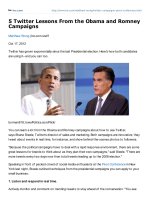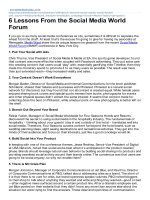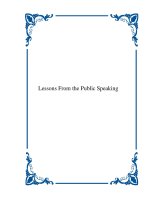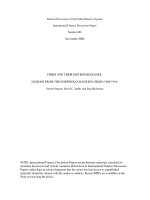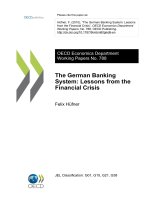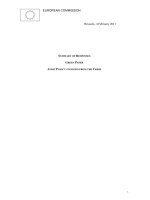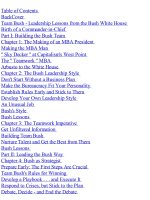10 Lessons from The 2013 Cannes Festival: Short guide
Bạn đang xem bản rút gọn của tài liệu. Xem và tải ngay bản đầy đủ của tài liệu tại đây (4.82 MB, 25 trang )
CANNES
10 LESSONS FROM CANNES
10
x
/2
10 Lessons From Cannes
EVERYTHING ABOUT
THE 2013 CANNES FESTIVAL
OF CREATIVITY WAS BIG:
THE CROWDS (A RECORD-BREAKING 12,000), THE AWARDS
(MORE CATEGORIES THAN EVER), AND THE CELEBRATIONS
(THE FESTIVAL TURNED 60 THIS YEAR, AND YES QUITE A
FEW PARTIES WERE HELD).
BUT NOT EVERYONE HAS THE TIME OR INCLINATION TO BATTLE
THE CROWDS IN CANNES, SO WE’VE CAPTURED TEN OF OUR
LEADING TAKEAWAYS FROM THIS, THE BIGGEST EVENT IN THE
MARKETING WORLD, FOR YOUR EDIFICATION AND AMUSEMENT.
(VISIT OUR BLOG FOR THE DAILY SUMMARIES, PHOTOS AND
VIDEOS WE POSTED FROM THE FESTIVAL.)
SUMMARY
/2
10 Lessons From Cannes
A CAVEAT: THIS IS HOW WE EXPERIENCED CANNES
AS A BRAND EXPERIENCE AGENCY. OTHERS MIGHT SEE THINGS
DIFFERENTLY. THE QUOTES AND LESSONS HERE ARE FROM THE
DOZENS OF SEMINARS WE ATTENDED, BUT WE DIDN’T ATTEND
EVERY ONE.
A CALL TO ACTION: THESE LESSONS APPLY
TO ALL BRANDS. THE DEGREE OF URGENCY MAY VARY, BUT ALL
OF US CAN LEARN FROM THESE LESSONS AND APPLY THEM IN
SOME WAY, SHAPE OR FORM IN OUR WORK AS MARKETERS.
AND OF COURSE,
WE’RE HAPPY TO HAVE THAT
CONVERSATION WITH YOU.
/3
10 Lessons From Cannes
/3
10 Lessons From Cannes
/4
10 Lessons From Cannes
10 LESSONS FROM CANNES
2 3 4 5
IT’S A
MAKER’S
CULTURE
PEOPLE
FIRST
#MAKELIFE
BETTER
EMOTION (STILL)
TRUMPS
TECHNOLOGY
1
6 8 9 107
BE
BRAVE
OUTSIDE
IN-NOVATION
CREATIVITY
g
BUSINESS
WE’RE ALL
STORYTELLERS
THE POWER
OF THE BRIEF
#WORK
THATMATTERS
NOW MORE THAN EVER, MARKETERS CAN’T AFFORD TO PLAY IT SAFE.
BE BRAVE
1
NO.
LESSON
/5
10 Lessons From Cannes
We counted at least three occasions
when executives of The Coca-Cola
Company—honored as the festival’s
marketer of the year—told the gathered
throngs to be bolder in their creative
ideas. Asked what he wants from
agencies, Coke’s global CMO, Joe
Tripodi, answered simply: “Challenge
us. Push us to be greater.”
“Be bold,” said Burberry’s Christopher
Bailey. “You can’t build a business case
around every decision.”
Agreeing from the agency side (albeit
in more colorful language), industry
legend George Lois practically
bellowed: “It’s not enough to have
talent. You have to have the courage to
fight for your work”—especially when
people at first say “no” to your ideas.
Speaking from the comedian’s corner,
Jack Black (in Cannes to talk about
the original series he’s created with
Priyanka Mattoo for Yahoo) said:
“Avoid the cliché. Fight the instinct
to go to the safe space.”
It’s not surprising that, at a festival
devoted to creativity, we’d hear a lot
of talk about bravery; the key thing
is to actually
be
brave. That’s hard.
Architect Rem Koolhaas suggested in
his Cannes seminar that our business
culture too often prioritizes comfort
over challenge, but it’s out of challenge
that new ideas emerge.
What makes us more confident that our
industry will actually be brave in 2013?
The simple economics of standing out,
for one. Coke has seen a turnaround
in recent years in part because it
aggressively pushed its marketing into
new territories; it was brave. “Safe”
marketing can actually represent a
bigger waste than a bold idea that tries
but fails. “The thing clients fear most,”
said Fernando Machado of Dove, “is
that nothing happens, because nothing
is different.”
BE BRAVE
1
NO.
LESSON
/6
10 Lessons From Cannes
2
NO.
WHAT PEOPLE EXPERIENCE ISN’T THE IDEA. IT’S WHAT YOU’VE MADE.
IT’S A
MAKER’S CULTURE
LESSON
/7
10 Lessons From Cannes
2
NO.
/8
10 Lessons From Cannes
“WE MAKE STUFF,” SAID JUST
ABOUT EVERYONE AT CANNES.
We’ve always known that there is a
terrific craft behind the filmmaking
represented in Cannes’ traditional
award categories, but our industry
requires a much broader definition of
the “stuff” that’s being made.
Today marketers need to create not
only ideas, but physical and digital
experiences, digital apps, and products
themselves. So marketers need to think
and act like makers.
At Jack we talk a lot about our “maker
culture”, which reflects the fact that
we’ve always created moments,
environments and experiences that
people interact with.
This year’s Cannes reinforces that
brands that are obsessive about the
experiences they create will thrive in
today’s maker culture. Christopher
Bailey spoke passionately about what
Burberry makes: not just luxury fashion
and accessories, but groundbreaking
fashion shows and live events, retail
stores and music, and experiences like
Burberry Kisses, a collaborative project
with Google.
We also saw changes to how agencies
are structuring their teams to be more
seamless makers. CP+B shared that
they’ve merged their teams so that
there are no “digital creatives”, and
Japanese creative technology company
Party has gone so far as to eliminate
all account director positions so that
“everybody is a maker”.
IT’S A MAKER’S
CULTURE
LESSON
3
NO.
WE DESIGN HUMAN EXPERIENCES.
PEOPLE FIRST
LESSON
/9
10 Lessons From Cannes
Johnny Marques, ECD of Jack Morton’s
New York office, led a workshop
at Cannes on Principles of Brand
Experience Harmony. For us, one of the
first principles of a great experience is
to build around the user. As experience
designers, any experience, regardless
of medium, starts with people; it has
to be relevant and customizable to
their needs.
This was a big theme at Cannes. Nick
D’Aloisio, the teenage founder of
artificial intelligence company Summly,
now part of Yahoo, predicted that
“the web ordered for you” will be the
digital experience that sets successful
brands apart in the future. He believes
that any brand that wants to do well
must adapt its digital experience to give
people three things that shape the web
around their needs: summarization,
personalization and curation.
Microsoft’s Stephen Kim and Bill Buxton
spoke of reinventing experiences
around people to enhance their lives.
Buxton asked why we continue to try
to put advertising in apps on mobile
devices, an experience that consumers
consistently rate somewhere between
neutral and annoying. “Instead of
annoying people by putting a pop-up
ad in your app, why not give people
something of value?” Buxton asked.
“Why not put an app in your ad?”
There’s an even more fundamental
“people first” point here: for Buxton,
“People are the real mobile devices.
Not the computing kind.” We’re the
ones that carry the mobile experience
with us, after all, and his advice to
marketers is to design experiences with
that in mind.
PEOPLE FIRST
/10
10 Lessons From Cannes
3
NO.
LESSON
IN THE FUTURE, MARKETERS WILL BE PROBLEM-SOLVERS.
#MAKELIFEBETTER
4
NO.
LESSON
/11
10 Lessons From Cannes
NO.
We believe that a core principle of great
brand experiences is to go beyond
simply communicating an idea and
actually add value to people’s lives.
Cannes showed us countless examples
of brands using new thinking and new
platforms to make life better (and thus
engage consumers in a whole new
way). In the best examples, they went
the next step to actually solve
consumer problems.
The very best examples of this
#makelifebetter attitude came out
of this year’s Future Lions winners,
comprised of student teams from the
US, UK, Japan and Germany.
Among the winning Future Lions
ideas, our favorite was “Pebble:
Sense Danger” by Thomas Bender
and Thomas Corcoran of School of
Communication Arts 2.0. (Of course,
we’re a bit biased as our London team
regularly works with their school and
were already big fans of “the two
Toms”.) Their idea is a simple tweak
of an existing product—the Pebble—to
help improve the lives of the hearing
impaired.
Brands that give people things they
truly want and need and that turn
marketing into problem-solving
immediately rise above the rest. It’s
always been true, and it’s even more
true in our noisy, distracted and time-
starved age.
#MAKELIFEBETTER
4
NO.
LESSON
/12
10 Lessons From Cannes
INNOVATION ISN’T EVERYTHING; EMOTION IS EVERYTHING.
EMOTION
(STILL) TRUMPS
TECHNOLOGY
5
NO.
LESSON
/13
10 Lessons From Cannes
5
NO.
As in years past, technology was a
huge presence at Cannes—but again
and again, we were reminded that it’s
called the “festival of creativity” for a
reason. Technology is a critical piece
of much of the interesting marketing
happening today, but it’s not the core
of great marketing: that’s the idea. Said
another way: Technology matters, but
the idea matters more.
And by the way, it wasn’t just creatives
at Cannes saying this (they would, of
course). A leading technologist from
Party asserted that “Innovation isn’t
everything; emotion is everything.”
Industry legend George Lois echoed the
sentiment: “The name of the game isn’t
technology; it’s creativity.”
It’s common sense, of course—you
don’t have to go all the way to the
south of France to learn that emotion
is the ultimate driver of effective
marketing. But it’s all too easy to
become distracted by a shiny new
technology and forget about the
message (or lack thereof).
The Titanium Grand Prix-winning
“Real Beauty Sketches” from Dove is
a terrific example of this. At its core
is a clear brief (show women they’re
more beautiful than they think) that
translated into a big idea (use a police
sketch artist to depict women as they
see themselves and as others see them),
which came to life as an emotionally
powerful film (the crucial moment of
which is delivered in the most old-
fashioned way, as we see one of the
women tearing up as she sees her two
sketches). The fact that the video was
shared online was incredibly important
(that’s how it became the most-viewed
viral video of all time), but the idea
mattered more.
Everyone agrees on one thing:
technology has not replaced ideas.
You need big ideas, not big technology
solutions. And don’t be fooled by
the latter.
EMOTION (STILL)
TRUMPS TECHNOLOGY
/14
10 Lessons From Cannes
LESSON
CHALLENGE OVER COMFORT.
OUTSIDE
IN-NOVATION
6
NO.
LESSON
/15
10 Lessons From Cannes
Everyone at Cannes seemed to agree
that innovation is a good thing. At a
festival of creativity, that statement
falls into the “duh” category, but there
was an important distinction. It’s not
about innovation for innovation’s sake,
but innovation that truly reframes the
problem in new ways.
Many speakers challenged us all to
be more innovative. Tumblr founder
David Karp posited that many existing
brand touchpoints are too limiting
and rule-bound. Dana Anderson
of Mondelez counciled brands and
agencies to work together in ways that
require more outside-in questioning of
established norms. Too much of what
we call “collaboration,” she contended,
is “superficial stuff”: it occurs within
homogenous groups that are isolated
and conflict-averse. Instead, she urged
marketers to seek outside views,
encourage debate and involve
people with divergent experiences
and perspectives.
Coca-Cola Company CEO Muhtar
Kent summed it up best: “The best
ideas aren’t inside the company;
they’re outside.”
OUTSIDE
IN-NOVATION
6
NO.
/16
10 Lessons From Cannes
LESSON
THERE’S A DIRECT LINE OF SIGHT BETWEEN
CREATIVITY AND PERFORMANCE IN THE MARKETPLACE.
CREATIVITY
g
BUSINESS
7
NO.
LESSON
/17
10 Lessons From Cannes
It’s a simple formulation that shouldn’t
really need to be stated (but here we
go): better creative thinking leads to
better business results. Yet there’s
enough cynicism around creative
awards generally (and Cannes
specifically) to merit re-stating just that.
All other things being equal, companies
with better creative marketing will
do better. Coke is a great example of
a turnaround based on a variety of
factors—of which marketing was an
important one. “We believe there’s a
direct line of sight between creativity
and performance in the marketplace,”
said Coke CMO Joe Tripodi at Cannes.
A few years ago, the IPA released
a study that showed creatively-
awarded work is twelve times more
effective than work that doesn’t win
awards. It makes brands famous and
sparks conversation, thereby driving
effectiveness. That’s essential to ROI—
and music to the ears of even the most
left-brained CFO.
Creativity in marketing is increasingly
connected to creativity that benefits
the whole business—witness the heavy
representation by brands like Intel,
Microsoft, Yahoo and Google at Cannes.
They were there not only to promote
partnership and media opportunities
with agencies and brands, but also
because they benefit from being part
of a global conversation that sparks
new thinking.
CREATIVITY
g
BUSINESS
7
NO.
LESSON
/18
10 Lessons From Cannes
ADVERTISING ISN’T DEAD; IT’S JUST REBORN.
WE’RE ALL
STORYTELLERS
8
NO.
LESSON
/19
10 Lessons From Cannes
A word-cloud of Cannes 2013
buzzwords would probably show this
one word bigger and bolder than any
other: storytelling.
Storytelling is so old, it’s new. At our
best, it’s what we’ve always done. It’s
a truly transmedia experience. How
we tell stories will (and must) always
change, but being good at storytelling
is tablestakes for our industry. If you’re
not good at storytelling, it’s time to find
a new job.
We waste a lot of time worrying about
the categorization of what we create,
(especially when awards are involved)
but storytelling is a greater uniter than
the media touchpoints that divide us.
In the words of Steven Althaus of BMW,
“I beg us as an industry to stop talking
about traditional and nontraditional.
Everything is just a way of telling a
story. We’re all storytellers here.”
Legendary creative director Lee
Clow, honored this year for his
lifetime achievement in the industry,
believes that all brand touchpoints
are part of a greater brand story. He
worries, however, that most brands
aren’t pulling together their various
touchpoints in a compelling way. “Every
touchpoint is an advertisement for the
brand. I still believe that brands need to
be focused on who they are and what
they believe. And right now things are
just too fragmented.”
The bottom line for brands: balance
a back-to-basics approach to
storytelling (i.e., be great at it) with a
stronger understanding of how all the
touchpoints in the broader brand story
fit together.
WE’RE ALL
STORYTELLERS
8
NO.
/20
10 Lessons From Cannes
LESSON
IT’S AS IMPORTANT AS YOU THINK.
THE POWER
OF THE BRIEF
9
NO.
LESSON
/21
10 Lessons From Cannes
Start with a bad brief and you end up
with bad creative ideas, or no ideas
at all. So it’s not surprising that at a
festival of creativity the power of a
good brief was such a frequent (albeit
under-the-radar) topic.
The biggest “good brief” star at Cannes
was the one-liner from Dove’s Fernando
Machado that led to Titanium Grand
Prix winner “Real Beauty Sketches”.
Research had shown that just four
percent of women think they’re
beautiful. Dove’s brief was this simple:
show women they’re more beautiful
than they think.
As Machado said, “The more you put
in the brief, the harder it is to get
good work.”
Which points to an important truth
about creativity: it starts with clients.
Dana Anderson of Mondelez delivered
a forum presentation on her company’s
efforts to get better creative work
by educating brand-side marketers
and agencies to collaborate more
effectively. One product of that effort:
an entire book on creating better
briefs, published by Mondelez’s
marketing team.
Keep an eye on Mondelez’s work in the
coming year – if their briefs really get
this good, their creative should too.
THE POWER
OF THE BRIEF
9
NO.
/22
10 Lessons From Cannes
LESSON
PURPOSE IS THE POWER BALL THAT DRIVES BRAND LOVE.
#WORKTHATMATTERS
10
NO.
LESSON
/23
10 Lessons From Cannes
Building marketing efforts around a
higher purpose is a proven way to
inspire true brand love. As Johnny
Marques, Jack Morton’s New York
ECD, said in his workshop at Cannes:
“Purpose is the power ball that drives
brand love—it’s the ultimate driver of
brand experience harmony.”
Purpose—or #workthatmatters—was
the core focus of a seminar led by
Coke’s Jonathan Mildenhall and Ivan
Pollard, in which they traced the
company’s rich history of connecting
to the most relevant topics of the day.
We’re all familiar with Coke’s recent
work—like Coke’s multiple Gold Lion-
winning “Small World Machines.” But
some of the work from their archives,
like a civil rights-era ad called “The
Bench”—that simply and powerfully
communicated the Coke’s point of view
on a segregation—was less familiar and
just as brilliant. The common theme?
Coke’s “stubbornly optimistic” value
system. The fact that Coke can connect
marketing from the 1950s to the 2010s
against a consistent set of beliefs is, of
course, hugely impressive.
Some of the most awarded work at
Cannes this year was truly work with
a purpose. One of the most impressive
and most acclaimed: “Dumb Ways to
Die,” which took a potentially dark
brief about decreasing needless deaths
and injuries in the Australian train
system and turned it into a viral music
video phenomenon. What’s amazing
about this irresistible experience is that
it simultaneously led to an over 20%
decrease in injuries and deaths and
made millions of people the world
over smile.
Now that’s #workthatmatters.
#WORKTHATMATTERS
/24
10 Lessons From Cannes
10
NO.
LESSON
Contact: Liz Bigham, SVP, Director of Brand Marketing
E:
T: +1 212 401 7212
Read our blog at blog.jackmorton.com
Follow us on twitter @jackmorton
Visit us online at jackmorton.com
About Jack Morton
Jack Morton Worldwide is a global brand experience agency with offices on
five continents. Our agency culture promotes breakthrough ideas about how
experiences connect brands and people – in-person, online, at retail and through
the power of digital and word of mouth. We work with both BtoC and BtoB
clients to create powerful and effective experiences that engage customers and
consumers, launch products, align employees and build strong experience brands.
Ranked at the top of our field, we earned over 50 awards for creativity, execution
and effectiveness last year.
Jack Morton is part of the Interpublic Group of Companies, Inc. (NYSE: IPG).
© Jack Morton Worldwide 2013
Talk to Jack
To read our earlier white papers, visit our Slideshare
channel at slideshare.net/jackmortonww
WHITE PAPERS
JACK

